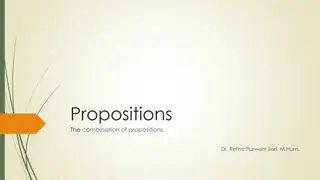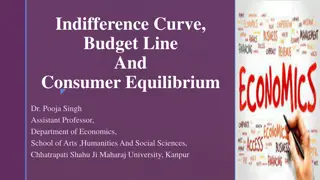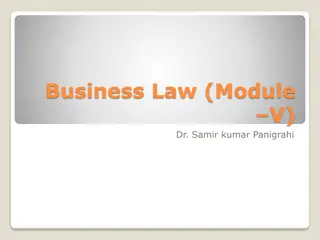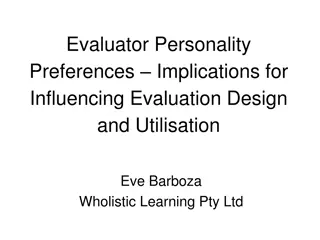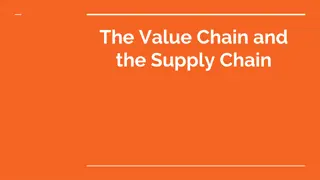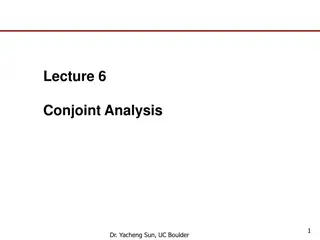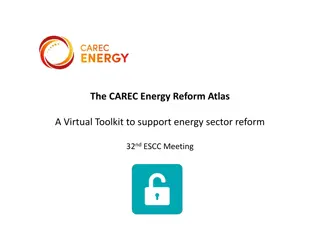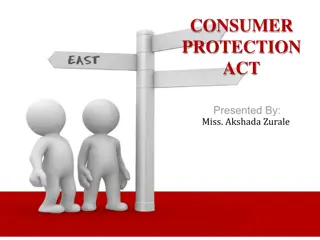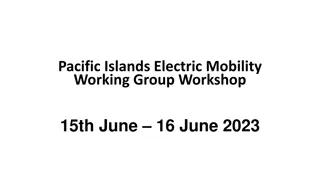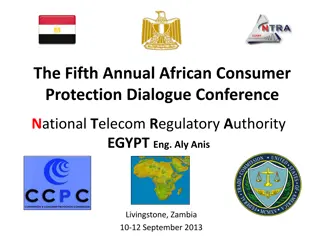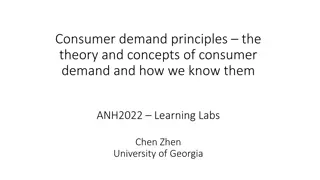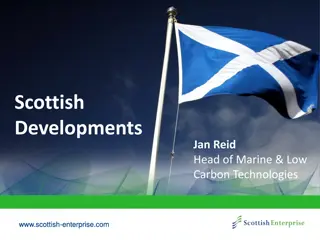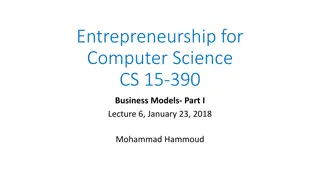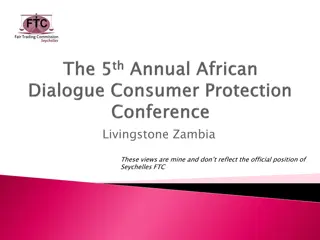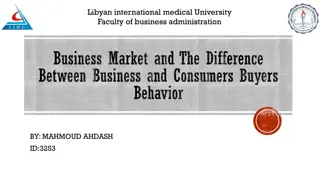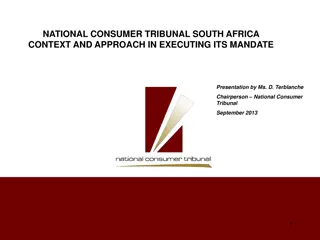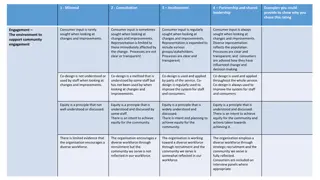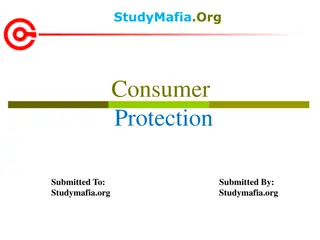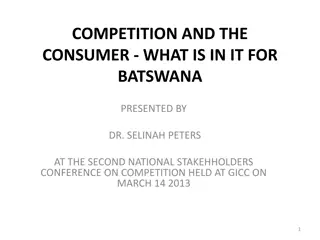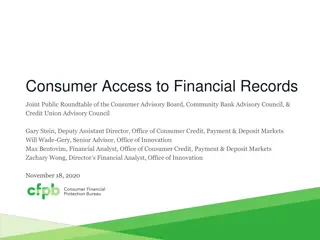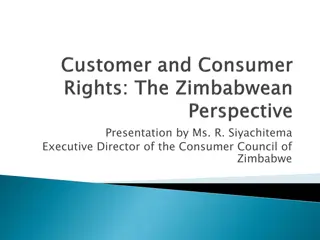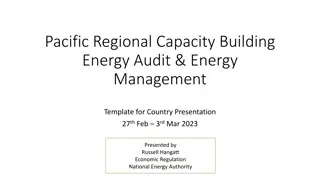The Future of Business Models in Energy Sector: Consumer Preferences and Value Propositions
Researchers from University of Leeds, Imperial College London, and Statistical Research explore consumer response to new energy service offerings and business models for the utility sector in the years leading up to 2050. The focus is on the potential financial value and cost savings achieved through deploying flexibility technologies, smart systems, and low-carbon energy generation capacities. Various scenarios and projections hint at the significant market opportunities and consumer benefits that could arise from embracing smart power solutions and sustainable energy practices.
Download Presentation

Please find below an Image/Link to download the presentation.
The content on the website is provided AS IS for your information and personal use only. It may not be sold, licensed, or shared on other websites without obtaining consent from the author. Download presentation by click this link. If you encounter any issues during the download, it is possible that the publisher has removed the file from their server.
E N D
Presentation Transcript
Do consumers want the new business models we can offer? Dr Stephen Hall, University of Leeds; Prof Jillian Anable, University of Leeds; Dr Jeff Hardy; Imperial College London; Yvonne Matthews, Statistical Research; Dr Chris Mazur, Imperial College London; Dr Mark Workman, Energy Systems Catapult.
Utility 2050 - Phase 1 How Much are Energy Futures Worth? What Business Might be Operating? And How will Consumers Respond to New Energy Service Value Propositions in 2035 to 2050?
Drivers for new system value / avoided cost The UK could save 17-40 bn across the electricity system from now to 2050 by deploying flexibility technologies Smart systems and flexibility plan 25% 2016 50% 2050 The UK is uniquely placed to lead the world in a Smart Power Revolution. If we get this right we could save consumers up to 8bn a year NIC Smart power report This research suggests that by 2050 up to 21 billion per year of new financial value is available in the UK electricity system Utility 2050 project 25 million 2050 15 million 2050 74 billion 2025
Scenarios DECC 2050 - Higher RE, more EE DECC 2050 - High Nuclear, less EE DECC 2050 - Higher CCS, more Bioenergy NGrid - Gone Green RTP - Market Rules RTP - Thousand Flower NGrid - No Progression RTP - Central Co-Ordination TWh 309 490 555 461 361 504 402 301 Electricity Demand Power Generation (incl. Import) TWh 349 530 610 556 454 573 464 370 Conventional Generation Capacity (excl. CCS) GW 49 0 0 0 18 15 5 0 CCS equipped Generation Capacity GW 0 13 2 40 11 46 32 23 Low-Carbon Generation Capacity GW 42 121 97 49 119 104 90 84 Number of Electric Vehicles mln. 3.9 24.2 31.0 24.4 9.7 25.2 25.2 25.2
Total Values to be captured per Pool Up to 21 bn of new value is available to electricity utilities per year by 2050 Plant efficiency 75 1809 m Service provision 5 9 bn Local LC generation 42 4600 m Large LC generation 0.61 8 bn Flexibility optimisation 400 2000 m CCS -0.14 1669 m 5
Market size and new value in 2050 RTP - Thousand Flower RTP - Central Coordination RTP - Market Rules Ngrid - Gone Green DECC 2050 - Higher CCS, more Bioenergy DECC 2050 - High Nuclear, less Energy Efficiency DECC 2050 - Higher RE, more EE NGRID No Progression 0.0 10.0 20.0 30.0 40.0 50.0 60.0 70.0 80.0 90.0 100.0 bnGBP New Revenues Avoided Cost Market Size
Capturing value: New business models Pure low-carbon generator New electrifier Traditional utility that is helping consumers switch to electric heat and mobility, including installing equipment and automating DSR Producing low-carbon power and selling directly to large customers or wholesale market Energy Service Company Third party control Peer-to-peer P2P customers directly buy, sell or swap electricity with each other. An ESCo delivers energy services to customers, such as comfort and illumination, rather than units of energy like a traditional supplier. A third party, such as a price comparison website, takes decisions on consumers behalf, like automatically switching energy supplier.
New Electrifier Same but Smart Free to switch companies as and when you want to You will have a smart meter with live information at home and on your phone etc Your supplier can see how and when you use electricity You can change your behaviour (not use the washing machine etc) when you see that electricity is cheaper You have a two-year contract You get a discount for switching your home from gas to electric heat It will cost about the same as now You might have some new things installed like electric radiators or a heat pump Your supplier can pause your heating occasionally for up to 15 minutes at a time, or take control of when to charge your electric car to help you avoid paying the highest prices, though you can opt out of this 3rd Party Controller You have a multi-year contract You tell the company how you want to live your life and it takes decisions on your behalf to deliver this You receive one bill for all your energy, broadband, TV, mobile phone, electric vehicle and water services Your company may offer to install equipment like insulation and a home energy management system to make your home more efficient and smarter Your company can pause your heating and appliances (such as your fridge) occasionally for up to 15 minutes at a time, or take control of when to charge your electric car to help you avoid paying the highest prices, though you can opt out of this Peer to Peer Energy Service Company You have a 10-year contract Your energy bills are guaranteed to be lower than you are currently paying for the duration of the contract You receive one bill for all your light, heat and any electric car needs You might have some new things installed, like insulation and a home energy management system Your supplier can pause your heating and appliances (such as your fridge) occasionally for up to 15 minutes at a time, or take control of when to charge your electric car to help you avoid paying the highest prices, though you can opt out of this You have no contract with an energy supplier You use an app on your phone choose who to buy energy from - you can choose based on price, type or location of energy. (For example, you might want local green energy, even though it might not be the cheapest) You can change who you get your energy from as often as you like If you have a solar panel on your roof you can make money by selling the energy from it through the app Paired Comparison design (=10 binary choices) 9
England & Wales Questionnaire Survey (2017) 1. To stress test 5 BMAs, + the current utility model (BAU), against consumer acceptability and acceptance 2. To measure importance attached to and acceptance of key BMA attributes (e.g. flexibility, control, automated switching, complexity, data ownership, reliability, greenness, localness , bundling of services, cost to consumer, peer to peer trading) 3. To identify consumer segments which differ on the basis of engagement, motivations, preferences, trust and stated intention to accept each BMA 10
Questionnaire design Section Topics 1. About your home House type; Ownership; Attachment to the home 2. About the supply of energy to your home Fuel supply; joint or single elec/gas supplier + reasoning; billing/ tariff/expenditure; understanding of bills 3. Heating your home Heating methods and fuel; satisfaction with heating system; perceived insulation level 4. Your energy use Perceived comfort; affordability and economic stress; concern re future energy prices; likely responses to price increases; engagement with current energy usage; smart meters; trust in information sharing; attitudes to demand control 5. Choosing your energy supplier Reasons for choice; satisfaction; switching behaviour and attitudes; switching other suppliers; trust in energy companies vis a vis other industries; general risk behaviour and innovativeness 6. Thinking about the future of your energy supply Paired choices between each archetype; attribute ratings for each archetype; overall likelihood to adopt each archetype 7. About your travel patterns Current car ownership and usage; attitudes towards electric vehicles; attitudes towards shared mobility 8. Other thoughts about energy and society Attitudes towards different forms of energy generation; energy supplier regulation; environmental beliefs/concerns 9. About you and your household Age; gender; household composition; disability; children; education; economic status; income etc 11
Included only those with some responsibility for energy supply in the household: Which one of the following describes your level of involvement in decisions about which company your household uses to supply gas and/or electricity? 1. It is my responsibility entirely 2. I have equal responsibility with someone else in the household 3. I have some involvement in the decision 4. I have no involvement at all THANK & CLOSE Sampling and achieved sample Aim for representative sample of electricity bill payers in England & Wales Online Survey administered through panel provider Final achieved sample N= 2024 12
Negative Attributes Positive Attributes Attractive Unattractive Straightforward Complicated Predictable Unpredictable Relaxing Stressful Flexible Inflexible Trustworthy Untrustworthy Fair Unfair Interesting Boring Safe Risky Good Bad Efficient Inefficient Cheap Expensive Liberating Oppressive Popular Unpopular Same as today Different from today
Demographic profiling Sample Average Engaged but Cautious Suspicious Opt- Outs Unengaged and Unmotivated Money- conscious Control Reliquishers 48.3% 42.6% 44.0% 53.9% 49.6% 56.0% % Male 47.3 50.4 44.5 55.1 37.1 44.3 Age_yrs 62.7% 66.5% 51.2% 71.0% 59.9% 62.7% Owner occupier 26.9% 20.9% 29.6% 12.7% 54.4% 29.1% Yes - Children Postgraduate/Profes sional education 46.4% 48.8% 43.8% 39.0% 55.2% 46.7% 56.0% 49.9% 59.4% 45.0% 75.0% 60.5% Working More likely: *Female *Not in work *No kids More likely: *Female *Younger *Renting More likely: *Male *Older *Own home *No kids *Low edu More likely: *Male More likely: * Younger *Renting *With kids *High edu Working (otherwise average) 19
Conclusions Consumers might be much more engaged than we think when offered meaningful choices. There is a market segment for each business model but messaging is critical. For peer 2 peer, suspicion of the regime is a driver. How legitimate or sustainable are pseudo peer to peer offers backed by a big 6 utility? Millennial renting families with high education may go for a third party control google runs your life but how stable are those preferences given the demographic? Trust is critical in the existing retail market, these data show trust and participation in new business models are pivotal. This would support a much more explicit role for innovation policy in building and understanding consumer trust TAKE HEART!! All this innovation does have a consumer base to go at. We just need to understand it better! 20
YES!! [some] Consumers DO want the new business models the sector can offer. BUT we must be EXTREMELY cautious if consumer trust, participation, and business model legitimacy are going to be a key determinant of the next phase of the energy transition. 21
Dr Stephen Hall. University of Leeds. s.hall@leeds.ac.uk Prof Jillian Anable. University of Leeds J.L.Anable@leeds.ac.uk 22




